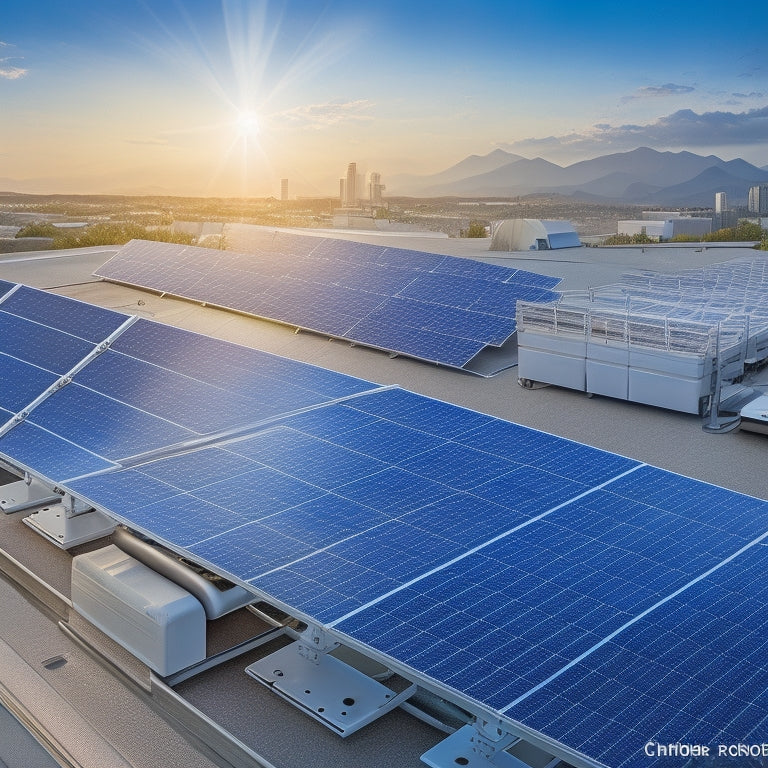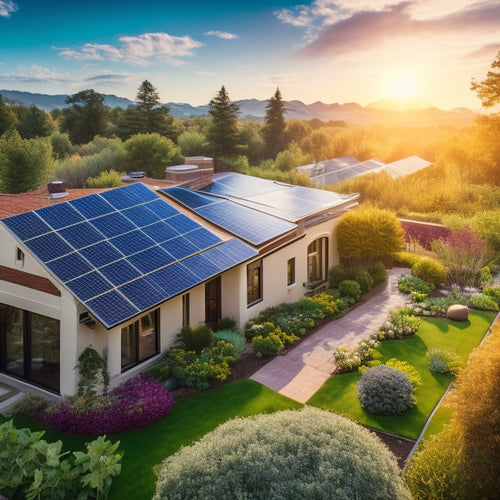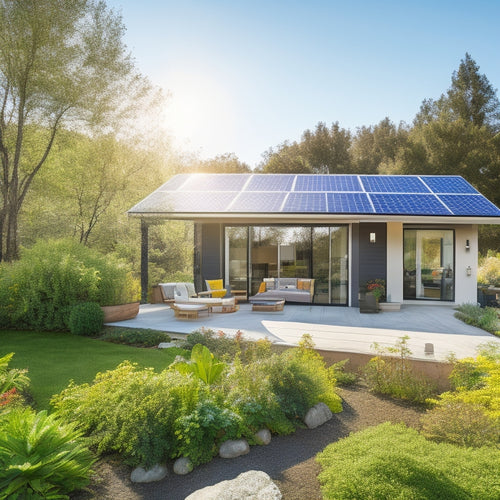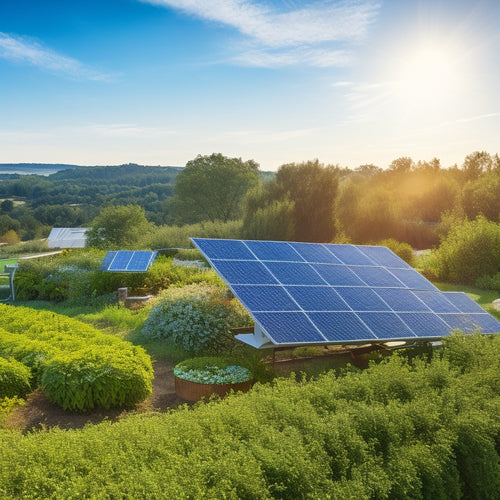
10 Essential Components of Commercial Solar System Costs
Share
You'll need to evaluate ten essential components when budgeting for a commercial solar system. These include system design and engineering, panel and inverter costs, mounting and racking systems, electrical infrastructure upgrades, permits and interconnection fees, energy storage system costs, monitoring and maintenance fees, land and roof lease costs, labor and project management costs, and financial incentives and tax credits. Each of these components plays a critical role in the overall cost of your system, and understanding their individual impacts is key to maximizing your return on investment. As you move forward, you'll want to examine each of these factors closely to guarantee a successful and cost-effective project.
Key Takeaways
- System design and engineering costs include collaboration with engineers, performance modeling, and energy efficiency analysis for successful installation.
- Component costs comprise solar panels, inverters, and energy storage systems, with panels accounting for 40%-50% of total system cost.
- Structural and installation components include mounting and racking systems, electrical infrastructure upgrades, and necessary permits and fees.
- Labor and project management costs involve installation labor, overhead, and project management fees, which vary by location and installer experience.
- Ongoing monitoring and maintenance costs, financial incentives, and tax credits are essential components to consider when calculating commercial solar system costs.
System Design and Engineering
Your commercial solar system's design and engineering phase is a critical component of the overall project, laying the groundwork for a successful installation.
During this phase, you'll work with engineers and designers to develop a customized system that meets your energy needs and budget. They'll employ system optimization strategies to guarantee maximum energy efficiency, using design software tools to model your system's performance and identify potential bottlenecks.
A thorough energy efficiency analysis will help identify opportunities to reduce energy consumption, while load assessment techniques will determine your facility's energy demands. Regulatory compliance requirements will also be addressed, confirming your system meets local building codes and permitting regulations.
Project timeline considerations will be factored in to guarantee a smooth installation process. Site assessment methods will evaluate your site's environmental impact, and environmental impact studies will identify potential risks and opportunities.
Panel and Inverter Costs
With the design and engineering phase complete, attention turns to the vital components of your commercial solar system: the panels and inverters. These components will greatly impact your system's energy yield and overall cost.
| Component | Cost Breakdown |
|---|---|
| Solar Panels | 40% - 50% of total system cost, influenced by panel efficiency, solar panel types, and warranties |
| Inverters | 20% - 30% of total system cost, dependent on inverter technology, lifespan, and placement |
When selecting panels, consider factors like panel efficiency, which can range from 15% to 22%. Higher-efficiency panels may be more expensive, but they can increase energy yield. You'll also need to choose from various solar panel types, such as monocrystalline, polycrystalline, and thin-film. Be sure to evaluate panel warranties, which typically range from 25 to 30 years. Inverter technology and lifespan, typically 10 to 15 years, also impact overall cost. Proper installation techniques and inverter placement are essential for best performance. A thorough cost breakdown and brand comparison will help you make informed decisions about these vital components.
Mounting and Racking Systems
Having secured the necessary panels and inverters, you'll need to verify they're properly mounted and secured to maximize energy yield and system longevity.
Mounting and racking systems serve as the backbone of your commercial solar system, providing structural integrity and weather resistance. You'll need to choose from various mounting materials, such as anodized aluminum or stainless steel, and racking types, including fixed-tilt, tracking, and adjustable-tilt systems.
Installation methods also vary, with options including ground-mounted, roof-mounted, and carport installations. When selecting a mounting and racking system, consider aesthetic considerations, such as the system's visual impact on your building or property.
Additionally, you'll need to decide on tilt angles, which can affect energy yield, and ascertain maintenance accessibility to facilitate future repairs and upgrades. Proper load distribution is also essential to prevent structural damage and guarantee the system operates within its design specifications.
Electrical Infrastructure Upgrades
As you integrate your commercial solar system into the existing electrical infrastructure, upgrading the electrical infrastructure becomes a vital step to secure a seamless and efficient energy flow. This upgrade guarantees grid compatibility, enabling your system to synchronize with the grid's frequency and voltage requirements.
Upgrading your infrastructure also extends its lifespan, allowing you to maximize your return on investment. Capacity upgrades are necessary to accommodate the increased energy output from your solar system. This may involve upgrading your electrical panels, transformers, or switchgear to handle the additional power.
Safety standards and regulatory compliance must also be considered to prevent electrical hazards and confirm your system meets local building codes. When planning your electrical infrastructure upgrades, consider energy efficiency, installation readiness, and system reliability.
You'll need to specify equipment that meets your system's requirements, ensuring peak performance. Budget considerations are also essential, as upgrades can be costly. By prioritizing these factors, you'll secure a reliable and efficient electrical infrastructure that supports your commercial solar system.
Permits and Interconnection Fees
When you're installing a commercial solar system, you'll need to contemplate the costs associated with obtaining necessary permits and approvals.
You'll typically need to pay application costs for permits from your local government, which can vary depending on the jurisdiction and project size.
Additionally, you'll need to secure a utility interconnection agreement, which may come with its own set of fees and requirements.
Permit Application Costs
Before installing a commercial solar system, you'll need to secure necessary permits and approvals from local authorities and the utility company. This involves maneuvering through complex application processes, which can be time-consuming and costly.
One of the significant costs associated with permit applications is the time and resources required to gather and submit necessary documentation. This includes environmental impact assessments, local zoning regulations, and application documentation requirements. Additionally, you may need to engage with stakeholders, such as local residents or business owners, to address any concerns they may have about the project.
Here is a breakdown of typical permit application costs:
| Cost Component | Estimated Cost |
|---|---|
| Application fees | $5,000 - $10,000 |
| Environmental impact assessments | $10,000 - $20,000 |
| Stakeholder engagement strategies | $5,000 - $10,000 |
| Project financing options (contingency fund) | $10,000 - $20,000 |
These costs can vary depending on the complexity of your project, local regulations, and the level of stakeholder engagement required. It's crucial to factor these costs into your overall project budget to guarantee a successful and financially viable commercial solar system installation.
Utility Interconnection Agreements
Your utility company's permission to connect your commercial solar system to the grid is vital, and that's where Utility Interconnection Agreements come in. These agreements outline the terms and conditions for connecting your system to the grid, guaranteeing regulatory compliance and meeting utility requirements.
The interconnection process involves submitting an application, paying applicable fees, and providing required documentation, such as system design and installation plans.
You'll need to negotiate the terms of your service agreement, including capacity limitations and interconnection costs. Effective negotiation strategies can help minimize costs and secure a timely project timeline.
Be prepared to provide detailed documentation, including system specifications, electrical diagrams, and certifications. Understanding the utility's requirements and the interconnection process is essential for a successful grid connection.
Installation Labor and Overhead
You'll need to account for labor hourly rates, which vary by location and installer experience, when calculating installation labor and overhead costs.
Moreover, project management costs, including planning and coordination expenses, will add to your overall expenditure.
In addition, you'll need to factor in an overhead markup percentage, which covers the installer's operational costs and profit margins.
Labor Hourly Rates
When evaluating commercial solar system costs, labor hourly rates play a vital role, as they encompass not only the cost of installation labor but also the associated overhead.
As you assess these rates, it's important to reflect on labor market trends, which can greatly impact your project's overall cost. For instance, areas with high labor demand or limited skilled labor supply can drive up hourly rates.
Regional wage differences also play an important role in determining labor hourly rates. You'll find that rates vary greatly depending on the location, with urban areas typically having higher rates than rural areas.
Additionally, rates can differ depending on the type of labor required, such as electrical or mechanical proficiency.
To accurately estimate labor hourly rates, you should research local labor market conditions, including prevailing wages and labor laws. This will help you develop a more realistic budget and guarantee that your project stays on track financially.
Project Management Costs
Labor hourly rates are just one aspect of the overall cost structure of a commercial solar system.
As you explore deeper into the project management costs, you'll find that they encompass a range of critical components that impact the project's success. Effective project management involves developing risk management strategies to mitigate potential setbacks, optimizing the project timeline to guarantee timely completion, and establishing stakeholder communication plans to keep everyone informed.
You'll also need to streamline the procurement process to guarantee efficiency, implement quality assurance measures to assure high standards, and employ budgeting techniques to stay within budget.
Resource allocation methods will help you delegate tasks and manage your team, while team collaboration tools will facilitate seamless communication.
Overhead Markup Percentage
How do overhead costs factor into the overall expense of a commercial solar system installation? As you calculate the total project budget, you'll need to evaluate the overhead markup percentage, which includes costs like office expenses, insurance, and employee benefits.
This markup is typically applied to the total installation labor cost and can vary depending on the installer's pricing strategies and profit margins.
Industry standards suggest an overhead markup percentage ranging from 10% to 30%. When estimating costs, it's crucial to factor in this markup to guarantee accurate project budgeting and financial forecasting.
A competitive analysis can help you determine the ideal markup percentage for your project, as it may vary depending on the region, project size, and installer's proficiency.
When calculating the overhead markup, assess the following: will the installer absorb some of the overhead costs to stay competitive, or will they pass them on to you?
Be sure to clarify the markup factors and pricing strategies with your installer to avoid any surprises down the line. By understanding the overhead markup percentage, you can better manage your project budget and secure a successful commercial solar system installation.
Energy Storage System Costs
The cost of an energy storage system (ESS) is a significant component of a commercial solar system's overall expense. When you're assessing an ESS, you're likely looking at a substantial upfront investment.
However, recent battery technology advancements have led to significant energy efficiency improvements, making ESS more cost-effective.
You'll need to factor in the cost of batteries, which can account for up to 70% of the total ESS cost. The type and quality of batteries you choose will impact the overall cost, with lithium-ion batteries being a popular choice for their high energy density and long lifespan.
Additionally, you'll need to evaluate the cost of inverters, electrical connections, and installation labor.
When evaluating ESS costs, you should also weigh the benefits of reduced energy consumption and peak shaving. By storing excess energy generated during the day for use during peak hours, you can reduce your reliance on the grid and lower your energy bills.
With the right ESS, you can optimize your energy usage and maximize your return on investment.
Monitoring and Maintenance Fees
When you invest in a commercial solar system, you'll need to factor in ongoing monitoring and maintenance fees to guarantee peak performance.
These costs will cover system performance tracking, which helps identify potential issues, as well as ongoing repair costs and scheduled inspection fees.
System Performance Tracking
Your solar panel system's performance data is essential for identifying potential issues and optimizing energy production.
It's vital to track your system's performance metrics, including energy yield, system uptime, and efficiency monitoring. This data helps you identify areas for improvement, ensuring you maximize your return on investment.
To achieve this, you'll need software solutions that provide real-time tracking and data analytics.
These tools enable performance benchmarking, allowing you to compare your system's performance to industry standards and identify opportunities for improvement.
You'll receive usage reports and operational analytics, equipping you to make data-driven decisions.
Ongoing Repair Costs
Commercial solar systems require regular monitoring and maintenance to guarantee peak performance, and this comes at a cost. As a commercial solar system owner, you'll need to budget for ongoing repair costs to make certain your system operates at its best.
The frequency of repairs will depend on the quality of your equipment and maintenance scheduling. It's important to take into account warranty coverage, spare parts availability, and service contracts to minimize downtime and repair costs.
Technician training and equipment lifespan also play an important role in reducing repair frequency. You should factor in emergency repairs, which can be costly, and allocate a budget for system upgrades as technology advances.
To avoid unexpected expenses, it's critical to have a repair budget in place. By understanding these factors, you can better plan for ongoing repair costs and maximize your system's performance.
A well-maintained commercial solar system can provide a significant return on investment, but neglecting maintenance can lead to decreased energy production and revenue loss.
Scheduled Inspection Fees
Regularly scheduled inspections are vital for guaranteeing your commercial solar system operates at peak efficiency, and these inspections come with a cost. As a solar system owner, you'll need to factor in the cost of scheduled inspections to ascertain your system is running smoothly and efficiently.
The frequency of inspections will depend on the size and complexity of your system, as well as the manufacturer's recommendations. Typically, inspections are performed quarterly or bi-annually, and may include a thorough inspection checklist to identify potential issues before they become major problems.
This checklist may include checks on electrical connections, panel cleanliness, and inverter performance, among other things. The cost of these inspections will vary depending on the provider, the frequency of inspections, and the level of service required.
When budgeting for your commercial solar system, it's crucial to factor in the cost of scheduled inspections to guarantee you're getting the most out of your investment. By staying on top of maintenance and repairs, you'll be able to maximize your energy output and reduce downtime.
Land and Roof Lease Costs
Across the United States, land and roof lease costs for commercial solar systems vary widely depending on factors such as location, land use, and lease duration. As you consider leasing land or a rooftop for your commercial solar system, you'll need to develop effective lease negotiation strategies to secure favorable terms.
Understanding local land zoning regulations is essential, as they can impact the feasibility and cost of your project.
Before signing a lease, conduct a thorough roof condition assessment to identify potential issues that could increase maintenance costs or reduce the system's lifespan. This assessment will help you factor in any necessary repairs or upgrades into your lease negotiations.
Lease term considerations are also significant, as longer lease terms can provide more stability and predictability for your solar investment. Conversely, shorter lease terms may offer more flexibility, but could also lead to higher costs and uncertainty.
Incentives and Tax Credits
With the rising adoption of solar energy, you can take advantage of various incentives and tax credits to offset the initial investment costs of your commercial solar system.
These financial benefits can notably impact your investment returns, making solar energy a more viable option for your business.
At the federal level, you're eligible for the Solar Investment Tax Credit (ITC), which allows you to claim a tax credit of up to 26% of the total project cost.
Additionally, you can depreciate your solar system's value over five years, further reducing your tax liability.
State credits and incentives also vary, but they can provide additional financial benefits.
For instance, some states offer rebates, grants, or property tax exemptions for commercial solar installations.
Frequently Asked Questions
What Is the Average Lifespan of a Commercial Solar Panel System?
You can expect a commercial solar panel system to last around 25-30 years, depending on panel durability and maintenance costs, with some systems lasting up to 40 years or more with proper upkeep and regular inspections.
Can I Install Solar Panels on a Metal Roof?
You can install solar panels on a metal roof, leveraging its advantages like durability and water-tightness, but be prepared to overcome installation challenges like ensuring secure mounting and accommodating roof curvature and seams.
Are Commercial Solar Systems Compatible With Backup Generators?
You can guarantee power reliability by integrating a backup generator with your commercial solar system, allowing smooth shifts between solar power and generator power during outages, and optimizing generator integration for efficient energy distribution.
Do Solar Panels Work Efficiently in Shaded Areas?
You'll find that solar panels don't work efficiently in shaded areas due to shading effects, which reduce panel performance; even partial shading can decrease energy output by up to 20%, making it essential to optimize panel placement and design.
Can I Sell Excess Energy Back to the Grid?
You'll be intrigued to know that 1 in 5 businesses in the US already generate their own electricity! Yes, you can sell excess energy back to the grid through net metering benefits and energy buyback programs, offsetting your utility bills and increasing your ROI.
Conclusion
You've finally made it to the end of this exhaustive list, congratulations! You now know the 10 essential components that'll drain your wallet when installing a commercial solar system. Don't worry, it's not all doom and gloom - you'll be saving the planet (and some cash on your energy bills) in the long run. Just remember, going green comes with a hefty price tag. So, go ahead and pat yourself on the back for taking the first step towards sustainability, but don't forget to cry about the cost later.
Related Posts
-

Sustainable Solar Energy for Cost-Effective Living
Adopting sustainable solar energy isn't just eco-friendly; it's a smart financial strategy. You'll slash your monthly...
-

Green Home Improvements Using Solar Power
Investing in solar power alters your home into a sustainable haven while slashing energy costs. You can greatly reduc...
-

Green Energy Alternatives for Independent Living
To enhance your independent living, consider green energy alternatives like solar panels and wind turbines. These opt...


